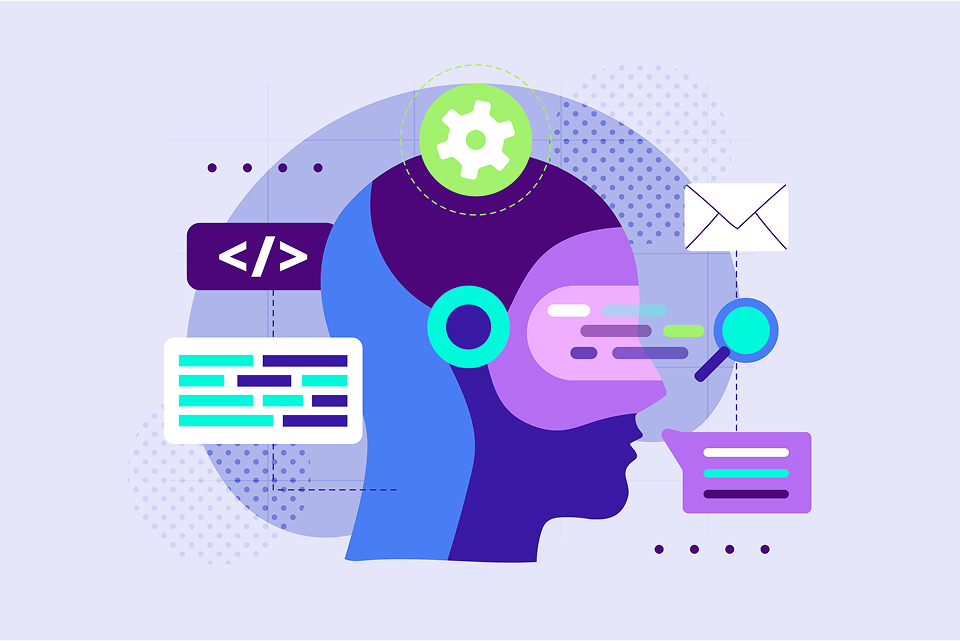Accessibility in web design means creating websites that everyone, regardless of ability, can use and enjoy. It’s about designing with empathy and inclusion at heart. Despite AI’s transformative impact, the importance of accessibility in web design has not diminished. Web accessibility technologies powered by artificial intelligence are indisputable. They offer amazing answers for problems that appeared unthinkable just a few years ago.
Everyone, including those with disabilities, has equal access to online material thanks to web accessibility. This encompasses a broad spectrum, including those with mental disabilities, physical disabilities, and vision and hearing impairments.
The Development of AI for Accessibility on the Web
AI has drastically changed the dynamics of the environment in a number of areas, including web accessibility. At first, AI methods were used to basic tasks like creating captions for videos or descriptions for pictures.
When they were created, these were impressive accomplishments, but the technology now offers much more complex options.
Important Elements of AI-Powered Tools for Web Accessibility
The primary obstacles that might be presented to the developers are listed below, along with solutions.
1. Adapting Dynamic Content with Machine Learning
Contextualized Adjustment: Dynamic content, such as single-page applications and material that reacts to user input, is present on the majority of websites nowadays. Such environments provide challenges for traditional accessibility assessments.
Analyzing User Behavior: AI can also identify common accessibility problems that particular groups face. Depending on the user’s choices, this method guarantees that potential solutions-like enhancing contrast or simplifying navigation-can be learned and put into practice.
2. Using Natural Language Processing (NLP) to Make Content More Accessible
Automatic Generation of Alt Text: While the earliest AI systems might have produced some simple alt text, by 2024, AI will be able to use natural language processing (NLP) to provide more descriptive and superior alt text based on its comprehension of the material.
Simplification of Content: Long articles can be rewritten in plain language for individuals with intellectual limitations by NLP algorithms.
3. Using Computer Vision to Provide Access to Visual Content
Analysis of Images and Videos in Real Time: Artificial intelligence can be used by automation to describe elements that a visually impaired user might find difficult to understand and to analyze material from visual images.
Recognition of Objects: Additionally, computer vision algorithms have improved accuracy rates when labeling things from photos and videos.
4. Automated Compliance Monitoring and Testing
Regular Audits of Accessibility: Additionally, they stop websites from being compliant with accessibility standards and then progressively slipping out of compliance as their design and content evolve over time.
Automated Cleanup: Apart from detecting issues, AI can also carry out fixes, such as altering color contrast, adding ARIA properties, or moving HTML to accommodate screen readers.

The Top 14 Web Accessibility Tools Powered by AI
1. AirCaption
A useful tool for those with hearing impairments, AirCaption converts sound and video content into accurate and accessible text. Users can alter captions to fit the audio in terms of time and content, and user data is processed locally to maintain privacy.
2. Play.ht
With artificial intelligence, Play.ht innovates text-to-speech apps to produce voices that are remarkably human-like. In terms of auditory perception, this enables users to customize their voice by adjusting its pitch and other characteristics. Additionally, the platform offers voice customisation, allowing users to produce unique character voices for specific projects.
3. UserWay
A full-spectrum digital accessibility solution, UserWay uses artificial intelligence to identify and fix problems with web content and apps. UserWay’s ability to facilitate continuous monitoring, auditing, and real-time adjustments makes it a powerful platform for long-term accessibility. Because UserWay consistently delivers web accessibility solutions, it is linked with many large enterprises.
4. AccessiBe
Making websites ADA or WCAG compliant is completely automated with AccessiBe, an AI tool. In order to make websites accessible to individuals with disabilities, it uses artificial intelligence to scan them and apply dynamic adjustments. Examples include improved keyboard controls, continuous compliance checks, and image identification for alt text production.
5. Murf
A business called Murf uses artificial intelligence to create voiceovers that seem natural from written screenplays. With its extensive library of voices in all the main languages and accents, the client can customize the synthetic speech to their preference.
6. Stark
Teams wishing to give accessible designs top priority will find Stark to be a useful tool. Designers can detect accessibility problems before they are implemented because to its flawless integration with design software like Adobe XD and Figma. For today’s dynamic accessibility teams, Stark is an essential tool due to its enterprise-grade security and affordability.
7. Read Easy.AI
Read ease.AI is a tool that helps persons with cognitive impairments or poor literacy levels read and comprehend material. Thus, after analyzing the content and outlining strategies for minimizing it, Read Easy streamlines the text by lowering the quantity of challenging words and making sure that the remaining words are spelled at least twice.
Explore more: Why Accessibility in Web Design Matters: A Complete Guide
8. Braille AI
Developed by the Braille Institute, Braille AI is a program that converts digital text into Braille and helps Braille readers understand Internet information. The platform uses a number of AI technologies to ensure that the translations are accurate and adjust to the necessary context.
9. Be My Eyes AI
The well-known software Be My Eyes AI enables persons with visual impairments locate sighted aids or virtual assistants with AI capabilities. The application’s AI component uses speech and picture recognition to provide on-demand assistance with tasks like object identification and reading labels or directions.
10. AudioEye
Web accessibility is automated via the AI-based program AudioEye, which also incorporates human intervention when needed. Through site corrections and alignment with ADA and WCAG standards, the tool improves accessibility. The fact that AudioEye offers long-term solutions that can notify users on a regular basis of emerging accessibility compliance issues is another benefit of employing it.
11. Recite Me
By offering a suite of integrated AI technologies, Recite Me is a novel solution that makes it simple for individuals with disabilities to explore websites. It provides functionalities for a range of accessibility needs, including screen scanning, translation, text-to-speech, and more.
12. Equally AI
The capacity of AI to use improved algorithms for website accessibility is another platform’s strength. Monitoring and dynamic content modifications are among the many capabilities it provides to guarantee that companies can adhere to accessibility regulations worldwide.
13. Allyable
Software called Allyable, which is based on artificial intelligence, helps website owners automate compliance. Using machine learning, the program can identify accessibility issues and provide recommendations in real time. Allyable is a reliable partner in building a more accessible web with monitoring and reporting tools that highlight unexpected obstacles and opportunities for development as they emerge over time.
14. Voiceitt
UserWay is a comprehensive digital accessibility solution that uses artificial intelligence to identify and fix problems with apps and web content. Because it enables continuous auditing, monitoring, and real-time adjustments, UserWay is a powerful platform for long-term accessibility. The program is excellent for all kinds of businesses because it is simple to use and can be installed by anyone, regardless of their or the company’s level of accessibility knowledge.

Problems and Things to Think About
While AI-powered web accessibility solutions offer many advantages, they also have disadvantages.
- Issues of Ethics: The artificial intelligence technologies in this situation are likely to replicate the bias present in the training data and provide accessibility solutions that are less useful for the target users.
- Complexity of Execution: In general, implementing AI accessibility features in a web environment can be difficult and necessitate a high level of IT proficiency. Organizations must be prepared to commit the necessary funds and manpower for implementation and training in order to do this.
- Continuous Maintenance: Similar to other software, these solutions are susceptible to obsolescence as new web standards and accessibility barriers are created.
- Concerns about Privacy: To provide targeted accessibility solutions, AI systems typically rely on user data. Because users’ personal information is gathered and processed, it is essential to ensure that it is handled appropriately and that privacy regulations are followed.
AI’s Potential Impact on Accessibility in Web Design
It seems undeniable that AI will continue to play a significant role in the effort to improve web accessibility in the future. The following are some trends to watch:
- AI-Powered Customization: With solutions for general user needs that are customized for each user, advanced AI technologies in the future will push personalization to new levels.
- Accessibility Activated by Voice: Given the widespread use of speech-activated AI assistants like Alexa and Siri, we may expect web accessibility solutions to progressively integrate voice commands.
- Accessibility of Virtual Reality (VR) and Augmented Reality (AR): As AR and VR become more widely used in the future, further support will be needed to ensure that tool-based accessibility support is effective in this environment.
- Cross-Platform Usability: Standard websites won’t be the only ones with web accessibility in the future. The trend toward mobile applications, smart devices, and other platforms must be addressed by AI technologies in order to provide smooth interactions across all interfaces.
Conclusion
AI-powered tools offer an efficient and effective way to create inclusive accessibility in web designs. They not only simplify compliance but also help ensure every user, regardless of ability, enjoys a seamless experience. With many user-friendly options available, there’s no reason to delay. These technologies make use of state-of-the-art computer vision, natural language processing, and artificial intelligence. They help guarantee more inclusive user experiences and ensure compliance in digital product interactions.
At InCreativeWeb, we specialize in crafting inclusive digital experiences that meet modern accessibility standards. Our team ensures your website complies with WCAG guidelines while remaining visually engaging and functional for all users. We integrate AI-powered tools to detect and fix accessibility gaps proactively. From audits to implementation, we guide you every step of the way. Let us help you make the web more inclusive, one design at a time. Contact our team today and build a website that works for everyone.
Author
Jayesh Patel
Jayesh Patel is a Professional Web Developer & Designer and the Founder of InCreativeWeb.
As a highly Creative Web/Graphic/UI Designer - Front End / PHP / WordPress / Shopify Developer, with 14+ years of experience, he also provide complete solution from SEO to Digital Marketing. The passion he has for his work, his dedication, and ability to make quick, decisive decisions set him apart from the rest.
His first priority is to create a website with Complete SEO + Speed Up + WordPress Security Code of standards.